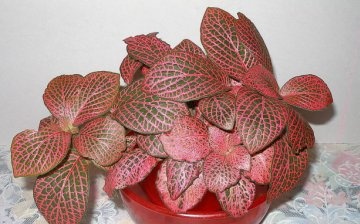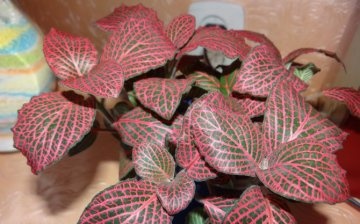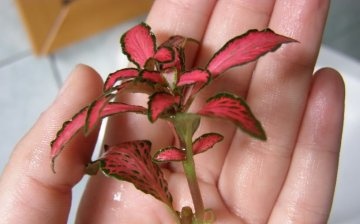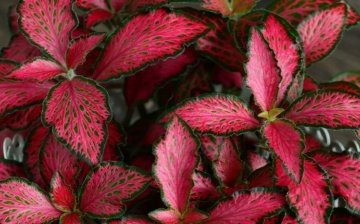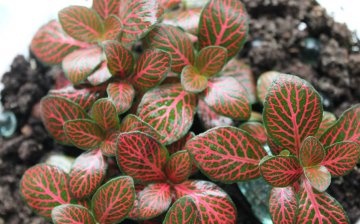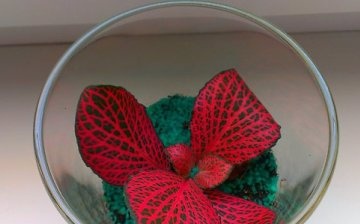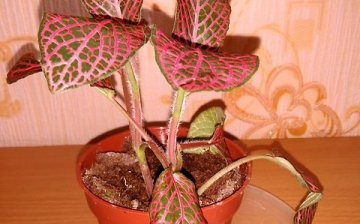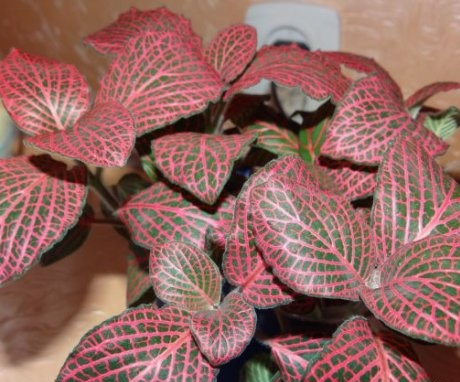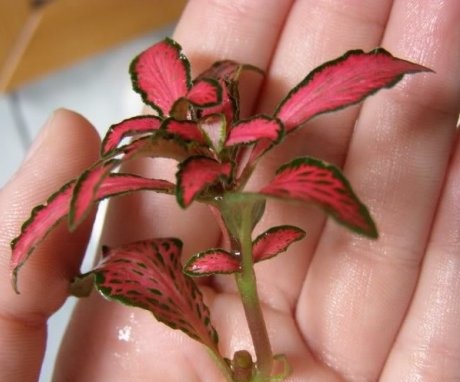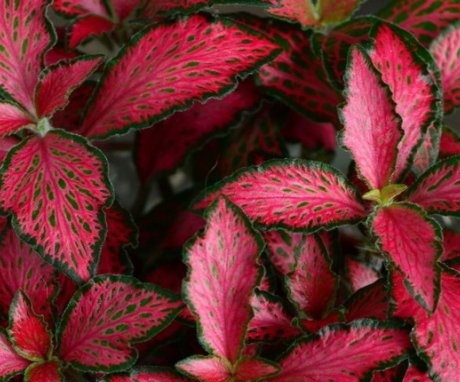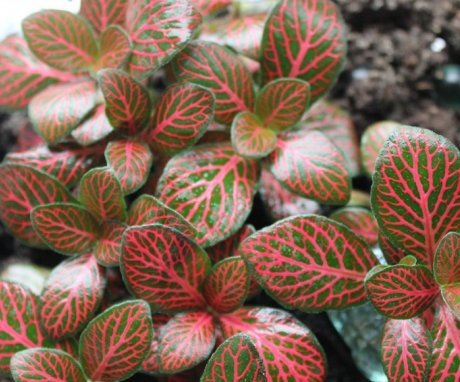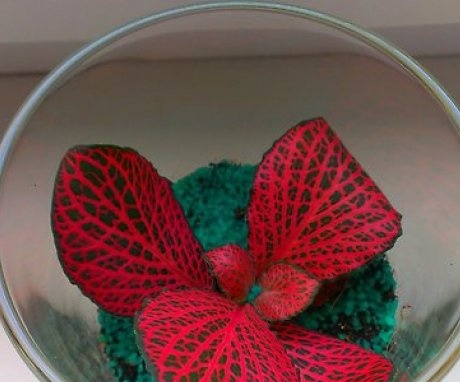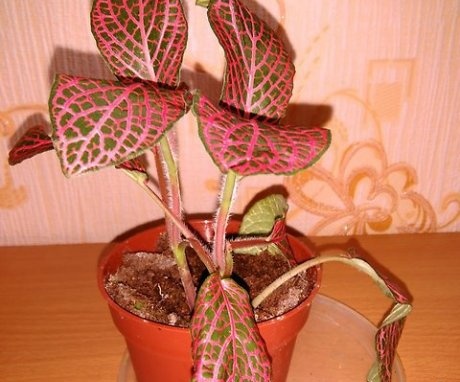Fittonia red: all about growing an indoor flower
Fittonia comes from the Acanthus family and is a herbaceous creeping plant. Its stems are tender, flexible, spread over the soil or slide down when planted in a flowerpot for indoor placement. Its original location was listed in various countries of South America. For proper cultivation, you must familiarize yourself with the rules of cultivation, planting and care.
Content:
- Indoor flower description
- Reproduction methods
- How to take care of it properly?
- Growing conditions
- When and how to transplant Fittonia?
- Possible growing problems
Indoor flower description
Fittonia red is a herbaceous, ground cover plant with creeping shoots. The plant stands out for its extraordinary color of leaf plates and insignificant growths in height, reaching 10 cm. The shoots of the bush are very flexible, upon contact with the ground, they quickly sprout adventitious roots, additionally rooting. Thanks to this method of reproduction, the plant has a superficial root systemeasily detachable from the soil substrate.
Fittonia red has nondescript and faded colors. For indoor rooting in decorative conditions, its luxurious leaves of excellent shape and bright tone are more important.
The leaves are oval, located on the stem on small petioles opposite each other, close enough. Each sheet plate has a blunt edge and is characterized by a smooth sheet surface. There is a small fluffy pile on the reverse side. The length of each sheet plate does not exceed 10 cm.
The foliage is presented with a bright olive shade. Veins of a lighter color are stretched along the entire leaf plate and cast with a glossy sheen. On young leaf blades, the veins can have different colors: white, yellowish or bright pink. As the greenery matures, the transverse veins acquire a standard greenish tone.
The plant blooms in spring or summer.
The appearance of the peduncle depends on the living conditions. The flower grows out of the bush's sinuses. The plant produces a peduncle naked in its structure, on which a large number of buds are located. The latter are collected in a spike-shaped inflorescence. The blossoming of flowers is carried out from the bottom to the top.
The flower is of little value. The tone of the inflorescences is very delicate - a light yellow hue. Corollas are small and close on the peduncle. From the bottom, the flower is covered with a stipule. The total size of the entire flower, together with the green part, does not exceed 1 cm. In nature, a small number of different species are distinguished - only 10 varieties. And only a few plants can be used for decorative cultivation.
Reproduction methods
The reproduction process takes place in a vegetative way. The optimal period for rooting is in the spring or summer months. At this moment, daylight hours have a larger light volume.
Features of cuttings:
- To obtain a viable shoot, it is recommended to cut off the top of the original flower no more than 8 cm.up to 5 healthy leaf plates must be present on it.
- The resulting cutting should be placed in a soil substrate, pre-moistened or water. The temperature of growing the root system on a new plant should be at the level of +25 .. + 28 C.
- After deepening the cutting, cover the plant with a plastic bag or plastic cup. This is required to maintain greenhouse conditions that quickly stimulate the formation of the root system of a young plant.
- Periodically, you will have to remove the film or cap in order to eliminate condensation, additionally moisten and ventilate the rooted plant. The germination procedure for young roots takes up to 2 months, provided that all the requirements for good growth are met.
When the root system appears, you can transplant it into open ground or into a large flowerpot. If the plant grows strongly, it is recommended to divide it into several bushes when transplanting. When transplanting a young bush, the transshipment method should be carried out so that the root system is not damaged and quickly takes root in a new place.
Another breeding method is to attach a young shoot to the ground. After the release of young roots, the formed young plant is detached from the mother bush and transplanted to a new place of residence. This method is considered quick, but more painful for the mother shrub.
How to take care of it properly?
In order for the plant to look neat and well-groomed, it is recommended to prune and pinch it. If you do not carry out these procedures, then the plant loses its decorative effect and overgrows. In the absence of pruning, the lower part, which is located closer to the roots, is stretched and exposed.
If pruning is carried out correctly, then new young shoots will begin to form in the leaf axils and internodes. The longest shoots should be chosen for cutting. It is recommended to eliminate the apical part without sparing the plant, cutting off the entire shoot by 2.
The main thing is not to pinch or cut off all the shoots at the same time.
In this case, you can drive the plant to such an extent that the shrub will die. He will not have enough strength to pull out a large number of young shoots. Therefore, it is recommended to rejuvenate the bush gradually. Such an event is held when the red fittonia reaches 3 years of age. Earlier carrying out of the procedure will not lead to the desired results. Rejuvenation of the creeping plant is required to be carried out in the spring before moving the plant to a new place of residence or after the process.
Plant care tips:
- Watering for Red Fittonia is very important. For the normal life of the plant, it is recommended to periodically moisten the soil well. Intensive watering should be carried out from the growing season (early spring) and carried out until late autumn. But you should not overfill the soil substrate in a flowerpot or overdry the soil too much. It is recommended to adhere to the optimal period between waterings - so that the soil has time to dry out slightly. If you overdry the soil, the fittonia will throw off all the foliage, and when swampy soil forms, rot will form on the rhizomes.
- To add nutrients to the soil, use only boiled or pre-collected, settled running water. After watering, water is required, which glass is removed from the pan. Stagnant water will provoke the formation of pathogenic bacteria and decay of the root system. In winter, the introduction of nutrient moisture should be minimized.
- To obtain a bright color of the leaf plate, you can make mineral dressing... During the growing season, this procedure is carried out 1 time in 14 days. For this, mineral fertilizers of a complex nature are used for indoor plants.In winter, the introduction of nutrient dressings is reduced to 1 time in 45 days.
Growing conditions
Fittonia is a plant with requirements for its care. If you do not pay little attention to this flower every day, it can wither and die altogether. Therefore, it is recommended to follow certain rules for successful cultivation.
- Lighting - the best place for placement will be the east or west window. The plant requires a large amount of sunlight, but it must be diffused so that the delicate leaves of a delicate shrub do not burn. If there are no options, and the bush is installed on the southern windowsill, then it is recommended to shade the bush in the summer noon hours. For placement on the north window, especially in the winter months, additional lighting will need to be installed for the shrub using phytolamp... If there is not enough light, then the stems of the plant begin to stretch, thin out and turn pale. They have an increase in the distance between the spans of the sheets. In such conditions, the leaf fades, its bright streaks gradually brighten, losing all the original decorative effect.
- For a quality fittonia living, you should adhere to the required elevated temperature. This plant is thermophilic and does not perceive a strong decrease in temperature, starting to die. For summer comfort, the plant needs up to +28 C, and in winter, the room temperature can be slightly lowered to +17 .. + 18 C. But with this content, it is recommended to constantly monitor the state of the flower. If the summer months are hot enough, then the room where the flowerpot with exotic is located must be periodically ventilated. But it is not recommended to install Fittonia in a draft, it can get sick. Exposing the plant to the open air in summer is not worth it. She is sensitive enough to sudden changes in temperature, so she can get sick or unintentionally shed foliage.
- As for the moisture content for the shrub, it should be increased. The plant must be sprayed daily from a spray bottle or a tray with water should be installed next to the flowerpot for natural evaporation. But after watering, it is forbidden to leave moisture in the pallet. Excessive moisture threatens rotting of the root system.
If the room temperature drops, watering and spraying is reduced to a minimum. Otherwise, fungus may develop.
When and how to transplant Fittonia?
When preparing to transplant a capricious plant, it should be borne in mind that the shrub has a delicate root system. It is located on the surface of the ground and is easily injured during transplantation. To root a flower in a new place, you should select a shallow flowerpot, no more than 7 cm high. The plant is a ground cover, in which the rhizomes do not burrow into the ground, but are in the outer layers. It is best to purchase a short but wide enough container. Its width should be at least 20 cm in diameter.
The main thing is that there are drainage holes at the bottom of the flowerpot so that excess water does not stagnate and flow into the pan.
When planting, the soil should be selected light, loose, so that it passes nutrient moisture and the necessary oxygen well. When planting, the acidity of the pH medium is checked - it should be at a neutral indicator. If it is not possible to make the soil yourself, then you can purchase a soil mixture for geraniums or violets... For self-preparation of the soil substrate, a mixture of turf soil (2 parts), peat (1 part) and coarse sand (1 part) is suitable.
Transplanting should be carried out every year at the beginning of the growing season - in March April. During planting, drainage should be laid in the selected flowerpot. Broken brick, expanded clay or sea pebbles are perfect as the first layer. Then pour out a sufficient amount of prepared soil.Carefully remove the plant from the old flowerpot, shake off excess soil from its root system and plant it in a new pot, adding the required volume of soil substrate. The last stage of transplantation is watering the plant.
Possible growing problems
Fittonia is a rather capricious plant. Therefore, gardeners often have problems with growing. A number of diseases and pests are identified that can contribute to the development of problems with the shrub.
But there are a number of cases where parasites and bacteria are not provocateurs of problems when caring for a flower:
- The leaf plate becomes wrinkled, dries up, an unhealthy appearance of the whole plant appears - the result of a similar well-being of the bush is a large amount of sunlight and excessively dry hot air. To eliminate the problem, fittonia should be shaded in the midday heat and periodically sprayed with a spray bottle.
- The foliage has withered and turned yellow - the condition worsens due to abundant watering. To normalize the condition of the plant, it is recommended to let the soil dry out and, after the next watering, remove excess moisture from the pan.
- The plant dies for no apparent reason - it becomes the result of strong waterlogging, carried out at low temperatures. To maintain the normal state of the plant, it is recommended to maintain the temperature regime and implement the watering rules.
- Black stripes appear at the tips of the leaf plates - a lack of nutrients in the soil is revealed.
- Fittonia threw off all the leaf plates - a long absence of watering, the soil is excessively dry. Watering should be normalized.
In order for the plant to feel normal and develop actively, delighting with its own decorative appearance, it is necessary to adhere to the rules of care. It is required to constantly monitor air humidity and temperature conditions.
Thus, Fittonia red is a demanding plant. When transplanting, certain points should be taken into account so as not to injure the root system. Improper care provokes a loss of flowering appearance, up to the death of the entire shrub.
More information can be found in the video:



